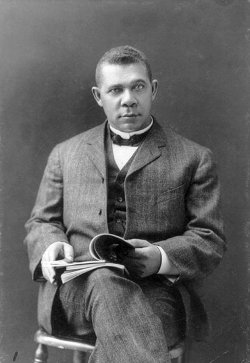INFORMATION - PEOPLE
BOOKER T WASHINGTON

... previous page
he also established the largest black organisation in the United States during the era of white supremacy: the National Negro Business League.
Through the creation of the National Negro Business League, Washington most effectively implemented his accomodationist theory economically. The organisation was founded in 1900 and aimed to develop African American businesses exclusively, through initiatives such as promoting and aiding advertisement of black business in widely distributed printed media. This reflects Washington’s philosophy that the African American community should strive to become self sufficient in order to contribute to the system as a whole.The National Negro Business League became an important economic organisation in the early Twentieth Century eventually established 320 chapters across America.
Washington’s ideas about creating a strong African American economic base inspired later leaders including Marcus Garvey. Garvey was the Jamaican leader of another important Early Twentieth Century black organisation: the United Negro Improvement Agency (UNIA). However, Garvey was more extreme in his philosophy then Washington advocating a total separatist strategy for the black diaspora in the Atlantic World. Harvard educated NAACP founder W.E.B Du Bois became Washington’s main opponent through. Despite initially being a follower of Washington’s Du Bois criticised him for not promoting protest, referring to him as ‘The Great Accommodator’. Du Bois argued that Washington and his ‘Tuskegee Machine’ would damn African Americans to permanent inferiority. Du Bois instead proposed constantly challenging whites for immediate social and political equality, through a ‘talented tenth’, a group of elite blacks that would represent and prove African American’s worth as a whole.
This difference in strategy formed one of the most significant debates in African American history. How should the black minority in the United States deal with oppression? Washington’s defense was that the outnumbered blacks would stand no chance if they confronted white racism. Instead, gaining white support gradually was the best way to overcome pervasive racism in the long term. Clashes between Washington, Du Bois and Garvey can be perceived as reflecting, in part, geographical differences. The fact Washington campaigned for a quiet uplift reflects the weak social position of African-Americans in the South.
The confusion of strategies became rivalry. After the Springfield Riot of 1908 Du Bois, taking a radical stand, criticised the actions of the white police. In turn, Washington condemned Du Bois for this, accusing him of being too provocative. This came to a head when, in reaction, President Woodrow Wilson began removing black government appointees. It was expected that the NAACP would intervene, but because it was Washington who had appointed them, the organisation refused to become involved. Washington later used his influence to prevent media support of the Niagra movement, another NAACP project.There were many achievements of the separate groups, but these public disagreements demonstrate the detrimental effect that intra-racial disunity could have on the cause for equality.
Since his death in 1915, Washington has often been remembered and criticised for placing too much emphasis on placating the white community. For this, he has often been labelled as a submissive ‘Uncle Tom’. This name refers to one of the racist stereotyped caricatures used by whites in the antebellum and Jim Crow era. It mocked the character in the famous novel ‘Uncle Tom’s Cabin’, and depicted a submissive, placid, ‘happy slave’. However as Thomas Sowell has argued, this is a grossly unfair image and in recent years Washington has been considered in a more positive light. As L. H. Walker has demonstrated Washington’s legacy is of lasting importance today, most significantly in initiating educational opportunities for black Americans.
Contributed by: HGF
| Continue the debate on Booker T. Washington |
Return to People home